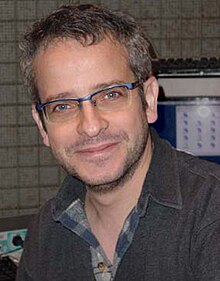Loading AI tools
French visual artist and theorist From Wikipedia, the free encyclopedia
Maurice Benayoun (aka MoBen or 莫奔) (born 29 March 1957) is a French new-media artist, curator, and theorist based in Paris and Hong Kong.[1]
This article has multiple issues. Please help improve it or discuss these issues on the talk page. (Learn how and when to remove these messages)
|
Maurice Benayoun | |
|---|---|
 Maurice Benayoun in 2000 | |
| Born | Maurice Benayoun 29 March 1957 |
| Education | Pantheon-Sorbonne University |
| Known for | New Media Art |
| Notable work | Quarxs (1991) Tunnel under the Atlantic (1995) World Skin, a Photo Safari in the Land of War (1997) |
| Awards | Golden Nica Ars Electronica 1998, Chevalier des Arts et Lettres 2000, Siggraph 1991, Villa Medicis hors les murs, 1993, Imagina, 1993, International Monitor Awards... |
| Website | www.benayoun.com |
His work employs various media, including video, computer graphics, immersive virtual reality, the Internet, performance, EEG, 3D Printing, large-scale urban media art, robotics, NFTs, and Blockchain based artworks, installations and interactive exhibitions.
He was Born in Mascara, Algeria, in March 1957, as a war orphan. His father was killed before his birth in the Algerian independence war. He moved to France in 1958, following his mother and his brother, to live in popular suburbs in north Paris where the family stayed during most of his childhood.
Bennayoun's doctorate thesis at the Sorbonne, Artistic Intentions at Work, Hypothesis for Committing Art, was published in 2011.[2]

Benayoun taught in contemporary and fine arts at Pantheon-Sorbonne University. In 1987 he co-founded Z-A Production (1987–2003), a computer graphics and virtual reality private lab.[citation needed]
Between 1990 and 1993, Benayoun collaborated with Belgian graphic novelists François Schuiten and philosopher Benoît Peeters on Quarxs, the first animation series made of HD computer graphics, exploring variant creatures with alternate physical laws.[3]
For his first solo show, Benayoun presented a virtual reality installation linking two art museums: the Pompidou Center in Paris and the Musée d'art contemporain de Montréal.[4] Benayoun conceived and directed the exhibition Cosmopolis, Overwriting the City (2005), an art and science immersive installation presented during the French Year in China in Shanghai, Beijing, Chengdu, and Chongqing. This was Maurice Benayoun's first experience in China, and the reception by the public played an important role in later Benayoun's move to Asia.[5]
Open Media, in 2000, considered his works as a form of Open Media Art, paraphrasing Jon Ippolito, not limited to the traditional forms, media and economic schemes of art, but also not necessarily based on a specific medium, digital or using technologies. Open takes here the sense of freedom in the means of expression.[6]
Infra-realism – (Infra-realisme in French, could be interpreted as 'sub-realism') was coined in the early 90s to describe the specificity of the new form of realism emerging from 3D computer graphics. During the production of Quarxs (1989–1993), the author, Benayoun wanted to identify the difference between visual realism based on the transcription of how the world reflects light, and what he called Infra-realism, or "realism of the depth" or "the deep realism behind the surface".[7]
This section of a biography of a living person needs additional citations for verification. (November 2021) |


Seamless Wikipedia browsing. On steroids.
Every time you click a link to Wikipedia, Wiktionary or Wikiquote in your browser's search results, it will show the modern Wikiwand interface.
Wikiwand extension is a five stars, simple, with minimum permission required to keep your browsing private, safe and transparent.